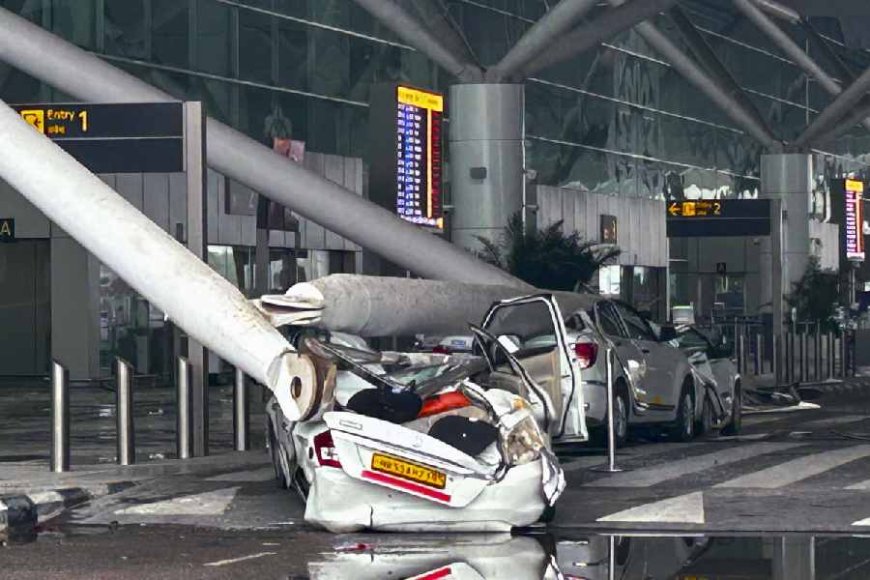Rain Wasn't the Culprit: Engineers Say Faulty Designs and Construction Caused Airport Canopy Collapses
Calls for stricter regulations and better oversight after string of incidents in Jabalpur, Delhi, Rajkot

Sections of structural experts stated on Saturday that a thorough inquiry is necessary into the structural failures that led to the consecutive collapses of the airport canopy in Jabalpur, Delhi, and Rajkot. They also disputed the theory that the disasters were caused by excessive rainfall.
Heavy rain either preceded or coincided with each airport canopy collapse, which happened in Jabalpur on Thursday, Delhi on Friday, and Rajkot on Saturday. However, according to engineers, at worst, the extreme precipitation would have made the underlying problems worse, which would have led to the disastrous structural breakdowns.
Authorities have attempted to attribute the breakdowns on a lot of rain. Rajeev Ratna Pandey, the director of the Jabalpur airport, for example, told the PTI news agency that the canopy had collapsed because of water that had gathered above it due to the rain. "The water's weight caused it to rupture, and the water crashed heavily onto an automobile."
Nonetheless, structural engineers think that each of the three mishaps might teach us something.
The Telegraph was informed by Sangeeta Wij, a former vice-president of the Indian Association of Structural Engineers (IASE), the highest professional organization, that "rain or water load should not be a challenge for either steel or concrete structures."
She mentioned that since large constructions are usually made of steel parts with hinged or permanent joints, concentrating on the joints could be one interesting area of research. Joints can be completed in a number of methods, including via welding, bolting, or connecting.
"Perfect execution is required for joints; the execution must adhere to the original design concept. Furthermore, improper execution may leave the joint exposed, the speaker continued.
According to Wij, when there is a lot of rain or wind, a weak joint could not be able to withstand the wind's ballooning impact, which could result in structural instability and a collapse.
According to a second structural engineer who works as an associate professor of civil engineering in a government university, poor maintenance is still another potential cause of problems.
Consider a scenario in which a joint portion has corrosion or other deterioration. The engineer, who wished to remain anonymous, warned this publication that heavy rain might then cause the damage to worsen beyond what is currently possible.
"Rainwater may affect an area that is already vulnerable, but it is not directly to blame. Timely repairs and proper maintenance could stop these kinds of malfunctions.
The structural engineering community, including Wij, is hoping that the airport canopy failures will force more reflection on what should be prioritized during construction projects, which they claim are being completed under extremely tight time constraints and with an increasing number of engineering procurement construction (EPC) contracts.
According to Wij, "there are instances when EPC contracts prioritize cost over aesthetics and structural safety."
On Saturday, June 29, 2024, the ceiling of Terminal 1 of the Indira Gandhi International Airport in New Delhi sustained damage. Following a roof collapse incident on Friday that left one person dead and six injured, operations at Terminal 1 have been paused.
On Saturday, June 29, 2024, the ceiling of Terminal 1 of the Indira Gandhi International Airport in New Delhi sustained damage. Following a roof collapse incident on Friday that left one person dead and six injured, operations at Terminal 1 have been paused.
PTI
According to several engineers, the lack of regulatory supervision over structural engineering practices allows "scrupulous engineers" to put the needs of contractors ahead of structural safety.
Since July 2022, the IASE has analyzed a number of incidents, including the failure of a precast arch over an expressway, the collapse of a canopy over a railway platform, and the collapse of a 95-meter bridge, in a quarterly newsletter called Crosfall (Confidential Reporting of Structural Failures and Lessons Learned).
Two years previously in Crosfall, an unnamed engineer had noted, "In our country, the system of review of structural designs and drawings by senior structural engineers is missing most of the time."
Among the causes of the different failures examined, the assessments in Crosfall have found rushed construction, inadequate structural design, and a mismatch between design and execution.
The majority of industrialized and developing nations have established engineering councils or other regulatory organizations for their structural engineers. To keep their licenses, engineers must pass an exam, get a license, and complete ongoing training, according to Wij.
We don't possess this. A much-needed Engineers Bill will ensure that structural safety is given more attention while also bringing greater accountability and respect to the profession.
Except for the headline, this story has not been edited by Press Time staff and has been published from a syndicated feed.





















































